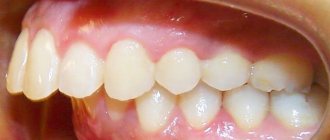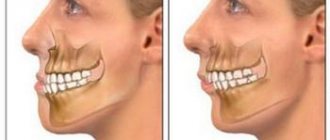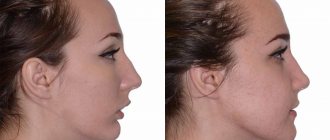Many conscripts whose father, uncles, cousins or brother served in the army have a normal attitude towards the responsibility of learning to defend themselves, loved ones and their homeland. And those whose father studied with him and had a military service, friends talk about the army as something terrible, they themselves are afraid, they don’t want to go there. Such guys, when they are practically healthy, place their last hope on a slight deviation in health and ask the orthodontist: “Are they recruited into the army with an incorrect bite?”
How to determine the degree of malocclusion
This term refers to the incorrect arrangement of teeth in a closed state. The defect, in most cases acquired, often develops in the first year of the baby's life. As you get older, the situation gets worse.
The main causes of malocclusion include:
- Artificial feeding using a pacifier, sucking a pacifier.
- Incorrect head position during feeding and sleeping.
- A bad habit is thumb sucking.
- Frequent diseases of the nose - sinusitis, congestion. The child breathes through the mouth, an incorrect taste is formed, and an “adenoid” type of face develops.
- Genetic data - heredity.
In addition, one of the main reasons for the formation of malocclusion is abnormal tooth growth. If you do not respond to the problem in a timely manner, the jaw and face as a whole become distorted. In this case, braces are used to correct the bite.
Types and classification of abnormal bite:
- Mesial, medial . It can be true or false. It is determined by the advancement of the lower jaw relative to the upper. One of the most difficult anomalies, practically impossible to treat.
- Distal, prognathic . Protrusion of the upper jaw forward or a severely underdeveloped lower jaw that does not reach the upper teeth.
- Deep . A common anomaly, as a result of which there is a strong overhang of the upper jaw over the lower jaw - by 1/3 of the crown of the incisors.
- Open , disocclusion . Rarely seen. There is a noticeable gap between the teeth when the jaws close. This phenomenon causes difficulty chewing food and incorrect pronunciation of certain sounds and words. There are anterior, posterior, lateral, false, true, unilateral, bilateral, gnathic, dentoalveolar. Difficult to treat.
- Cross, scissor . It represents the intersection of the dentition in the horizontal plane. An incorrect smile and pronunciation of words are formed. There are buccal and lingual types.
The Agapov classification helps to assess the severity of the anomaly. If the closure separation is observed to be 5-9 mm, they speak of malocclusion of the 2nd degree, less than 5 mm - 1st degree, more than 9 mm - 3rd degree. The quality of chewing food is also assessed. The substrate is examined under a microscope, the percentage of grinding is calculated, and compared with normal values.
An abnormal bite can be determined visually, but a specialist must make a diagnosis and record it in the outpatient chart. In most cases, with a timely response from parents to the problem, the situation is resolved for the child. It is more difficult for an adult to correct a defect.
Reasons for the incompatibility of abnormal bite and military service
The army requires conscripts to speak clearly, and one of the consequences of an abnormal bite is impaired diction.
This is not the only problem that occurs in people with pathological closure of the dentition. Other complications include:
- Facial deformation.
- Gum diseases.
- Difficulty digesting and assimilating food.
- Disturbances in the functioning of the respiratory system.
- ENT diseases.
- Damage and premature wear of tooth enamel, etc.
Some forms of deformation are incompatible with the conditions of military service. Complex bites include deep bites when the upper teeth overlap the lower teeth by more than half their length. A severely protruded upper jaw is considered a serious deviation. This sign characterizes the distal bite.
If there is a lack of contact between the lateral and anterior teeth during closure, the anomaly is designated as an open bite.
According to orthodontic indications, all forms of severe tooth displacement that disrupt digestion and affect the functioning of other systems and organs are grounds for dismissal from service or granting a deferment. This is due to the fact that the army does not have the ability to provide military personnel with the necessary medical care and services.
With minor deviations in the structure of the dental system, there are no obstacles to military service, but there are restrictions. For example, those liable for military service are not allowed to join the flying troops.
Serving in the Air Force involves frequent use of breathing apparatus with mouthpieces. The recruit will not be drafted into the elite troops (Navy, Airborne Forces, Ministry of Emergency Situations, etc.), since among the requirements for conscripts is the presence of category “A” for health reasons.
Do they take into the army with a deep bite?
According to Article 56 of the Schedule of Diseases, a conscript has the right to be exempt from military duty in two cases:
- anomaly of 2 degrees with separation of 5-10 mm, with chewing activity less than 60%.
- anomaly of 2, 3 degrees with separation of more than 10 mm.
All other forms are conscription. The defect in grades 2 and 3 of malocclusion is visible to the naked eye. The conscript is sent for additional examination to determine the degree of chewing of food. If the anomaly can be eliminated, the young man is offered surgery. If the procedure is successfully completed, the summons will be served after 6 months. If it is impossible to eliminate the defect or the conscript refuses the operation, he is assigned fitness category “B” and released from service.
Types of bracket systems
The existence of a wide variety of brace systems is explained by the fact that for many people wearing them has become not only of a health-improving nature. If a person wears braces for a long time and wants to look decent at the same time, then he may have a desire to purchase visually more beautiful models:
- Plastic ones are affordable for most patients, but the low cost comes at the cost of fragility. Best suited for treating mild bite problems for a short period of time.
- Metal braces are one of the most common correction methods due to their low cost and effectiveness. The metal is durable and easy to clean.
- Ceramic braces are gaining popularity due to the fact that plates of the right color can be almost invisible to the eye. “Ceramics” does not change color over time, practically does not cause allergies, and in terms of strength it is slightly less than metal.
- Sapphire braces are based on single crystals of an artificial mineral. They have a transparent appearance, are practically invisible to others, and require careful handling since they are more fragile, unlike their metal and ceramic counterparts.
- Lingual braces - the high price is compensated by their complete invisibility to others. They are placed on the inside of the teeth so as not to show signs of treatment of the jaw apparatus. These braces are made of gold and metal, which also justifies the cost.
Anomaly of 2 degrees with separation of 5-10 mm
According to Art. 56 Schedules of diseases, item “b”, fitness category “B” is assigned for defects of the lower jaw, the presence of transplants after surgery. Pre-conscription conscripts upon initial registration with the military registration and enlistment office are considered to be of limited fitness - category "G" if less than 6 months have passed since the operation.
In case of malocclusion of the II degree with a separation from 5 to 10 mm with a chewing efficiency of less than 60%, in case of an malocclusion of the II, III degree with a separation of the bite of more than 10 mm (without taking into account the chewing efficiency), suitability category “B” is assigned. In case of malocclusion of the II degree with separation from 5 to 10 mm with a chewing efficiency of 60% or more percent - “B”.
For those examined with non-removed metal structures after osteosynthesis of fractures of the maxillary bone and (or) mandible with minor or no impairment of respiratory, olfactory, chewing, swallowing and speech functions, paragraph “B” applies.
If there is a malocclusion of the first degree, a displacement of the dentition by less than 5 mm, the conscript is drafted into the army.
How the face changes due to impaired jaw closure
Malocclusions carry a pronounced cosmetic defect
. This is an unattractive smile, changes in facial proportions, for example, a too protruding lower jaw, a constantly slightly open mouth. A massive, heavy chin also does not add attractiveness to the face, because it makes the jaw look much larger.
Photo 3. A woman’s face in profile with a malocclusion (left) and after correction of the pathology (right).
The appearance of gaps between the lateral dental sections causes facial asymmetry and the effect of “sunken cheeks”
as if the lateral teeth were completely absent. To all this you can add a somewhat confused and surprised-stupid expression on the face, which does not suit the person at all.
Of course, an incorrect bite changes the face and asymmetry appears. This happens because the teeth on one side wear away faster. With age, this problem only increases.
How does a military commission make a decision?
If there is an abnormal arrangement of teeth, you should seek help from a dentist. The diagnosis, the degree of chewing dysfunction, and the severity of the disease are determined by a specialist. The information is recorded in the outpatient card. You must take a photocopy of the statements with you to the commission at the military registration and enlistment office.
The commissariat examines the conscript, studies the preliminary notes of doctors, and sends him for additional examination. After re-confirmation, a fitness category is assigned. If the defect can be corrected with treatment, a deferment is given for 6-12 months, after which the conscript’s case is reconsidered.
Useful tips
Doctors recommend correcting bite defects as early as possible. In childhood, the root system is very mobile, so the teeth move easily. Accordingly, correction takes a shorter period than during treatment in adulthood.
Young men should plan to correct malocclusions, taking into account the possibility of conscription for military service. The best option would be to contact an orthodontist long before adulthood.
Wearing braces for each patient proceeds individually, depending on the characteristics of the body.
When undergoing service with braces, some complications may arise, which are quite difficult to correct:
- Poor digestion;
- Abrasion and damage to enamel;
- Inflammation of the gums;
- Increased tooth sensitivity;
- Impaired diction;
- Distortion of facial features.
If the above violations occur, immediate assistance from an orthodontist is required.
Will they be accepted into the army with braces in 2022?
Professional installation of braces is an expensive procedure that requires constant supervision by specialists and special dental care. Special food is provided. In the army, all these conditions cannot be met. However, according to the Schedule of Diseases, exemption from the army with fitness category “B” is not allowed. The exception is surgery to correct a grade 2 malocclusion with a separation of more than 5 mm.
In some cases, the military commissariat meets the conscript halfway, gives him time to complete his treatment, assigns category “G”, after which a re-examination is scheduled. If a young man has braces, he should consider removing them before going into the army, since it will not be possible to provide full care for the oral jaw.
Who is considered fit for service?
According to the degree of health suitability for military service, there are categories:
- "A".
- "B".
- "IN".
- "G".
- "D".
What category you have will be determined by the military medical commission when you undergo a medical examination. Group “B” is called up, but group “C” is not. Some fairly healthy young people want to break the law and want to be assigned category “B” and released from service.
Before passing a special medical examination, it is best for you to visit doctors and ask how healthy you are, are you subject to compulsory conscription or not? All categories except the last “D” are subject to change.
For example, at the time of conscription your arm was broken and you received category “G”. After 2 months the bones will heal during a second medical examination after 6 months. and moreover, you feel great. You may be given category “A” or “B” and taken to serve in the army.
Categories
Let's take a closer look at the categories:
- "A" is good health. Fit for military service.
- “B” health is normal, but there are some limitations. Detected deficiencies do not prevent you from serving. For example, myopia is slight.
If you have category “B”, then it is customary to specify: “B-1” or “B-2”, which means “B-3”, etc. 1, the most that the restrictions are less than with 3. Conscript with “B” will not be hired to serve in the navy or as a paratrooper. They recruit strong young men there.
- Your “B” is fit for service, but with restrictions. In fact, experts believe that he is not fit to have serious health problems. You will not be drafted, but will be enlisted honorably in the reserve.
- “G”, it is believed that the young man is currently (temporarily) serious about serving, and later, when he recovers, for example, from an injury of varying severity, the military registration and enlistment office will send him a summons. There will be a chance in 6 months. or 1 year to enter the service.
- “D” Thus, he is definitely unfit to serve. There will be no re-examination.
Next Conscription into the armyDo people with kyphosis join the army?
Reviews
Dear readers, you can leave your feedback on whether people with an incorrect bite are accepted into the army in the comments, your opinion will be useful to other users of the site!
Andrey
“Theoretically, we can do everything, practically nothing. You still need to be able to prove an incorrect bite. They are sent to the army with major defects.”
Oleg
“I got braces shortly before the commission at the military registration and enlistment office, I thought it would help me get a deferment. No, they said, take it off and go ahead and serve.”











